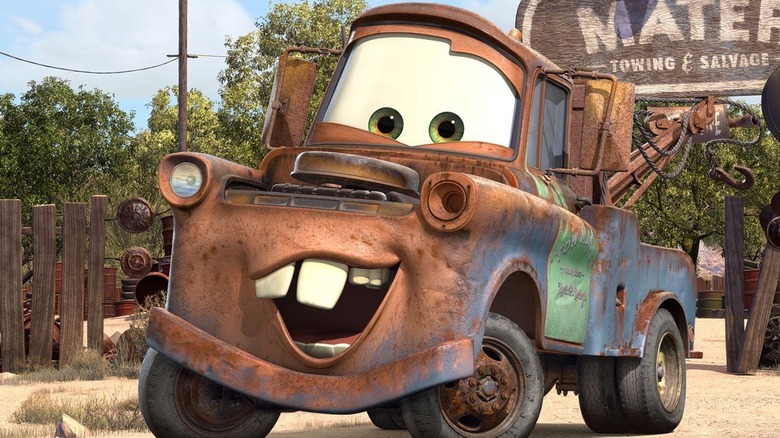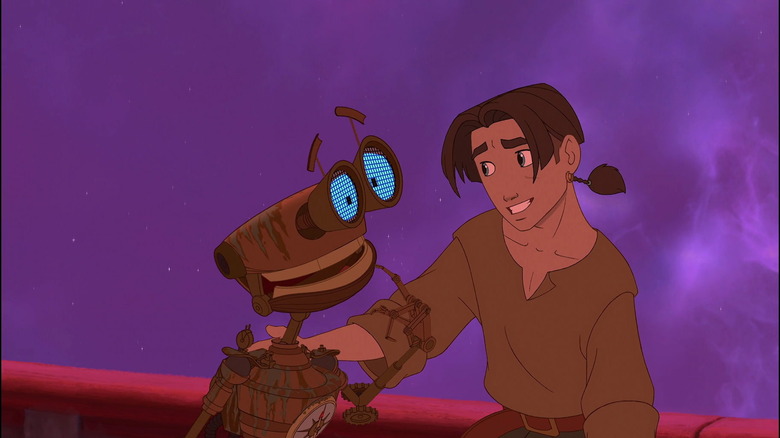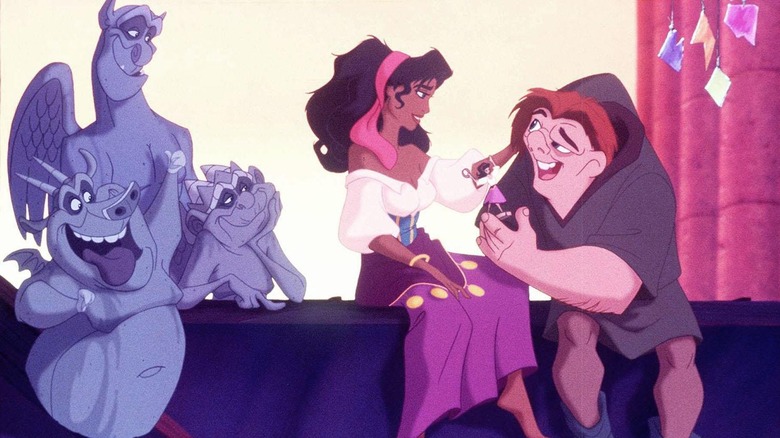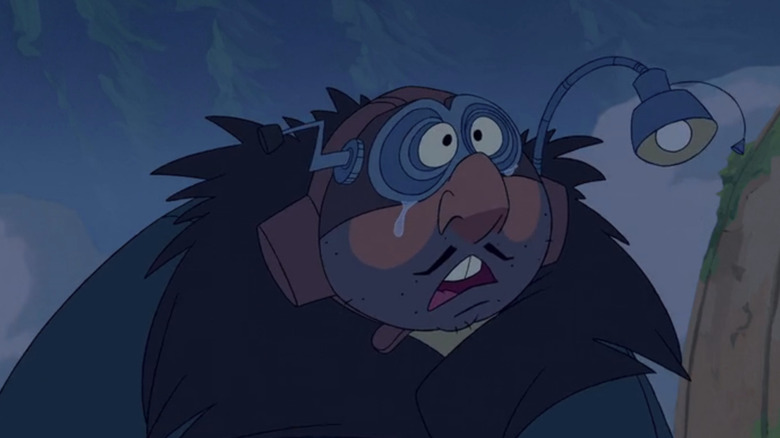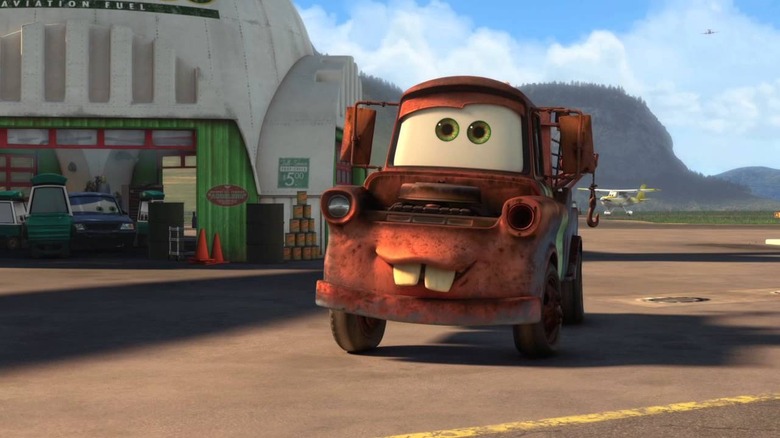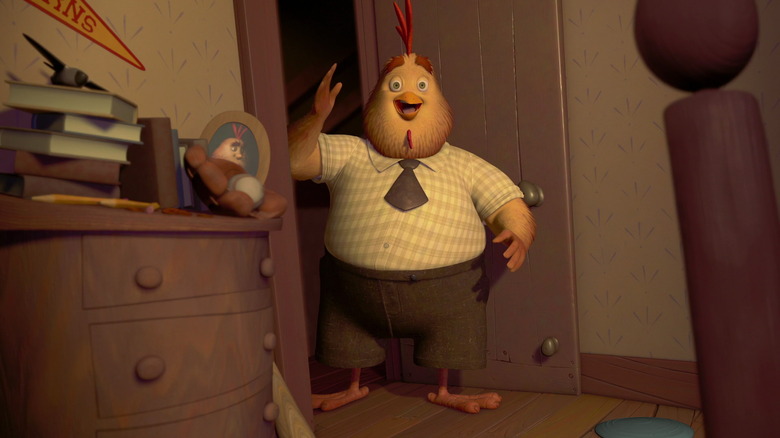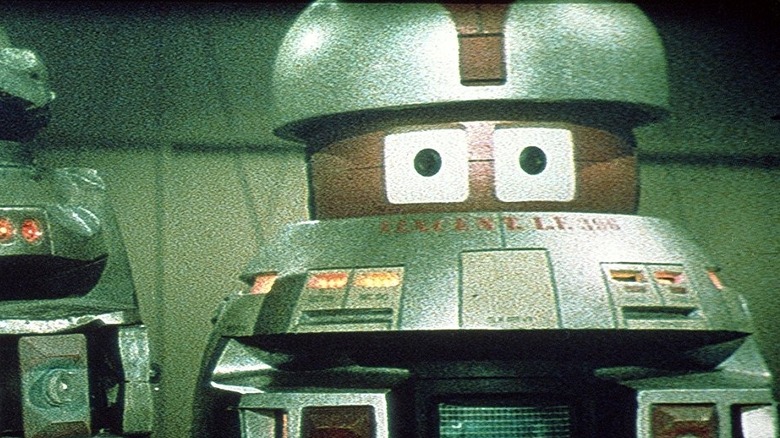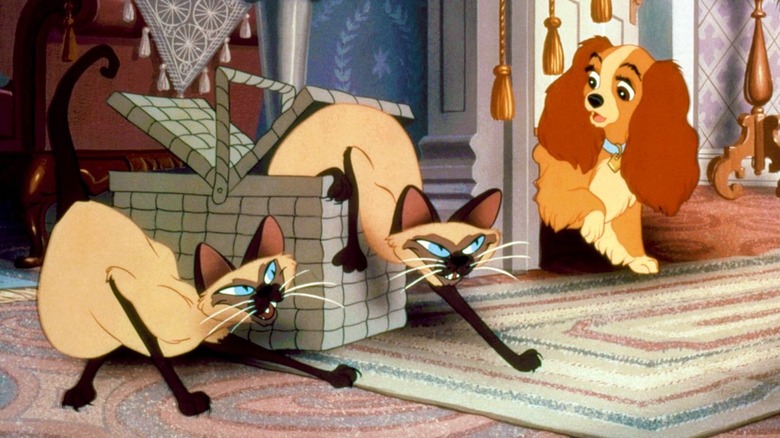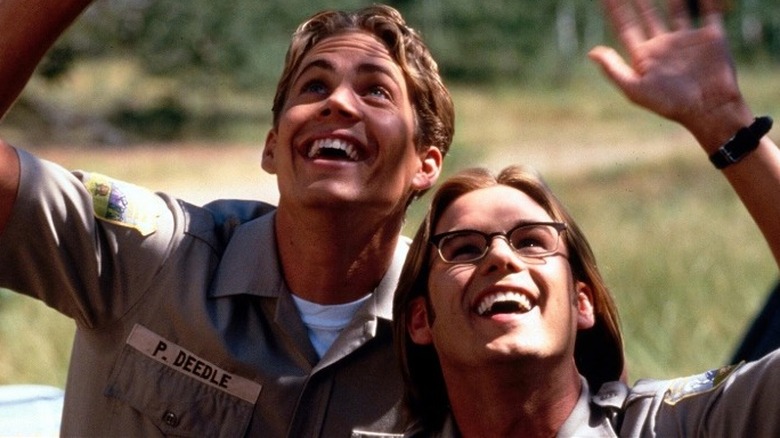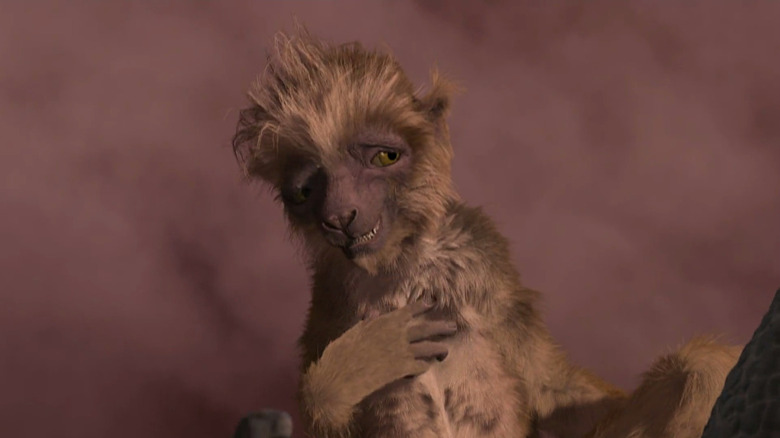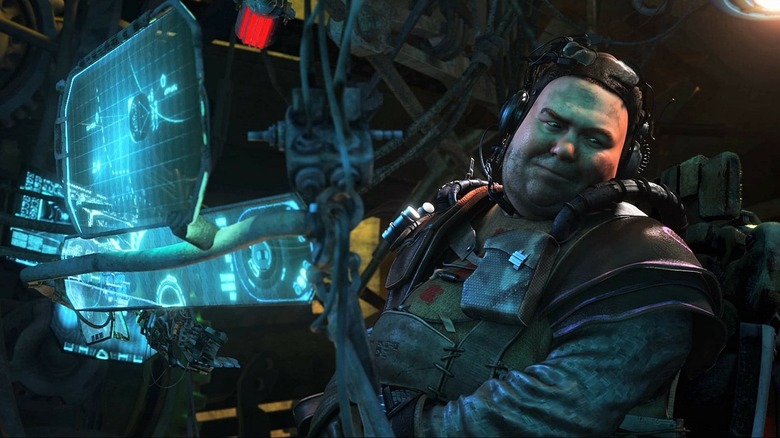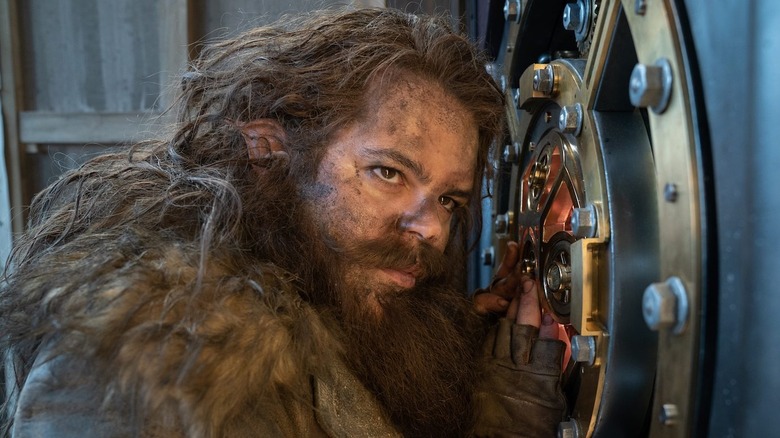Disney Characters Fans Can't Stand
The history of pop culture is littered with Disney characters that have become beloved all over the world: folks like Buzz Lightyear or Elsa, who bring joy to people of all ages and whose most iconic lines have become woven into everyday discourse. But given that Disney has been producing pieces of entertainment culture for nearly a century, not every new character created by the company is destined to become the next Jack Sparrow. Disney has a number of fictitious figures who didn't just fail to garner much popularity but have become downright reviled by die-hard fans.
The factors that separate these characters from all-time great Disney figures like Mickey Mouse vary greatly. Sometimes a vocal performance or character design inspires chagrin; other times, it's the fact that a certain character seems frustratingly superfluous in the broader scope of a movie. Whatever the reason for their universal lack of acceptance, it's clear that these are the kinds of Disney characters you won't find kids declaring as their all-time favorite. Rather than inspiring adoration, these characters are merely used as punchlines or examples of what happens when that Disney magic gets lost.
B.E.N. from Treasure Planet
If you're going to do an adaptation of "Treasure Island" worth its salt, it has to include the character Ben Gunn. This stranded castaway is a fixture of Robert Louis Stevenson's seminal text and most of its adaptations, and even a science-fiction version like "Treasure Planet" wasn't about to eschew such a staple. In keeping with how everything from the book was updated to reflect the world of the future, this incarnation's Gunn is a robot named B.E.N., whose missing memory chip proves crucial to the plot.
Voiced by Martin Short, B.E.N., in concept, is a clever way to reinterpret the literary character in a science-fiction context. However, the execution leaves something to be desired. Arriving late into the movie (a narrative choice inherited from the source material), B.E.N.'s presence feels a bit forced. Why must the tortured surrogate father/son dynamic between Long John Silver and Jim Hawkins be disrupted for more robotic antics? The very brash vocal performance from Short also makes the character harder to swallow and leaves one wishing B.E.N. had some sort of volume control the viewer could easily access.
The Gargoyles from The Hunchback of Notre Dame
Over the years, many parts of "The Hunchback of Notre Dame" have garnered widespread acclaim, particularly its gorgeously realized animation and Alan Menken's beloved score. But there's one part of the movie that nobody tends to like: The trio of comedic gargoyle sidekicks that accompany Quasimodo while he's locked away underneath the bells of Notre Dame. Victor, Hugo, and Laverne are a group full of loud noises and goofy lines that just don't fit the movie they inhabit.
Whereas much of "Hunchback of Notre Dame" is about grim songs contemplating theology, lust, financial inequality, and other weighty themes, the gargoyles keep barging in to undercut the gravity of the feature. An attempt to make sure that kids in the audience weren't alienated, they only served to undermine the film's efforts to go deeper than your average animated Disney movie. Even creative participants in the project have regrets over how the Gargoyles turned out. In a retrospective published for the 25th anniversary of "Notre Dame," writer Brenda Chapman noted that she wasn't sure the gargoyles worked in execution, particularly during their overly wacky musical number "A Guy Like You." That sentiment went far beyond just the people who worked on this project and has spread to the general public as well.
Mole from Atlantis: The Lost Empire
According to the DVD features for "Atlantis: The Lost Empire," the crew of the movie wore T-shirts proclaiming that the film would distance itself from past animated Disney films by featuring less singing and substantially more explosions. However, one way this feature did not differentiate itself from other Disney titles was through the overdone presence of a comedic sidekick — in this case, Gaetan "Mole" Molière (Corey Burton), a tiny, hunched-over man who is obsessed with dirt and can barely communicate with the others. His antics throughout the film include putting a whoopee cushion on one character's seat and getting awful mad when someone fiddles with the ornately organized mounds of soil on his bed.
Mole feels like an odd concession to the traditional Disney Animation formula in a movie that largely eschews it. He also feels superfluous, as "The Lost Empire" has plenty of other humorous side characters who provide levity to the story. Mole is one more farcical individual cluttering up the screen — and for that matter, he isn't even that funny. His schtick gets really old really fast, and his hyperactive nature makes him more likely to irritate viewers than amuse them. In a feature that often broke the mold in intriguing ways, Mole is an aspect of "The Lost Empire" that feels all too familiar.
Mater from Cars
Pixar movies tend to have characters that stick in your mind because they aren't afraid to tackle challenging concepts. Carl Fredrickson in "Up," for example, is a cantankerous curmudgeon, but his navigation of the process of grief makes him someone you can understand and get dramatically invested in. By (very) stark contrast is Mater, the comic sidekick of the "Cars" movies. There's nothing deep going on with Mater: He's just an automobile version of his voice actor, Larry the Cable Guy, whose personality dominates the screen whenever he rolls into the story. This doesn't work as well in an animated film about automobiles as it does for the stand-up comedian on his own stage.
Though clearly written to be like a puppy dog, so full of energy and affection that you couldn't turn him away, in execution Mater is just grating. A little bit of Larry the Cable Guy goes a long way, and his vocal performance as Mater in the first "Cars" movie makes it even harder to pin down the character on a screenwriting level. These issues got even more difficult when "Cars 2" rolled around and Mater was upgraded to protagonist. He's just not a character you can hinge an entire movie on. Going this route made Mater's status as an automobile that people just can't stand more apparent than ever before.
Buck Cluck from Chicken Little
Single dads are common in the world of animated Disney movies. Typically, we see such figures struggling to figure out what to do when it comes to connecting with their offspring or grappling with the absence of their significant other. But none of them are as callous as Buck Cluck, the titular character's father in "Chicken Little." A malicious fowl who makes the likes of Maleficent look tame, Buck Cluck spends much of the first half of the film insisting his son stifle his ambitions and do anything but stand out. If this were a dark indie film, Buck Cluck would be an unambiguous antagonist like the alien invaders in "Chicken Little," but this feature tries to paint him as just as misguided but loving a father as the likes of Marlin from "Finding Nemo."
Things only get worse when Chicken Little himself becomes a baseball star like his father and Buck Cluck finally approves of his outcast child. Having the love of your parent depend on baseball stardom is not exactly a great parent/kid dynamic. The fact that the film remains oblivious to the severity of Buck Cluck's actions makes the character all the more uncomfortable to watch. While Buck Cluck isn't the first single Disney dad to display imperfect behavior, he's certainly one of the most egregious characters of any kind in the studio's canon.
V.I.N.CENT from The Black Hole
Much like "Star Wars" two years prior, Disney's big-budget sci-fi film "The Black Hole" from 1979 had its own comedic robot to help drum up some laughs from the audience. Unlike the beloved C-3PO and R2-D2, though, the robot V.I.N.CENT was not a well-liked creation (much like "The Black Hole" itself). In fact, you could look at V.I.N.CENT as a symbol of how much "The Black Hole" fell short of its aspirations of delivering something on par with "Star Wars."
The biggest problem with the character lay mostly in his design. A retrospective review of the project with Jim Knipfel for Den of Geek noted that the rigidly shaped body and painted-on eyes of V.I.N.CENT made the character look like "a giant Playskool toy struggl[ing] to be charming." Knipfel also mentioned that focusing so much of the plot on a character this devoid of expression or memorable personality was one of the critical shortcomings of "The Black Hole" as a film.
With these flaws, V.I.N.CENT never became the kind of loveable comic relief he was intended to be, despite Roddy McDowall's valiant (though uncredited) voiceover performance. The fact that V.I.N.CENT and fellow "The Black Hole" robot B.O.B. were so clearly emulating C-3PO and R2-D2 also drew further criticism and highlighted how much this 1979 Disney sci-fi feature failed to escape the shadow of the film it was imitating.
The Siamese Cats from Lady and the Tramp
Midway through "Lady and the Tramp," Lady's world gets upended by the presence of two felines, named Si and Am, who proceed to wreak havoc on her home. As they do this, the two cats begin to sing a song proclaiming that they're "Siamese [cats], if you please," among other lyrics. With the recurring banging of a gong on the soundtrack and the extremely stereotypical accents of the characters, it becomes apparent immediately that these felines represent problematic caricatures of Asian individuals.
Anyone who's waltzed through the world of Disney Animation knows that racist stereotypes are bound to creep into otherwise soft and gentle proceedings. "Lady and the Tramp" is no exception, with these two characters proving especially impossible to stand due to how much they disrupt the film. This is partially intentional due to all the chaos they cause in Lady's home, but more than that, they stand out as jarringly mean-spirited in a movie where animal characters are largely depicted with a sense of empathy. The fact that there's also not much more in their personality than causing mischief also makes Si and Am among the more uninteresting animals in "Lady and the Tramp" even before getting to their harmful, racist qualities.
Swifty La Rue from Superstar Limo
It seems like everyone that rode it has a different least favorite part of the ill-fated Disney California Adventure ride "Superstar Limo." Was it the cheesiness of the interior and exterior design? The showbiz gags that felt out of date even in 2000? Or perhaps it was the figure that greeted guests at the start of the ride, a caricature of slimy Hollywood agents named Swifty La Rue. This crusty fellow gives riders their instructions to meet their agent for a glamorous contract, setting the celebrity-filled "adventure" into motion.
Like everything about "Superstar Limo," Swifty La Rue was a poorly conceived creation, largely due to the simple fact that parodies of grubby showbiz agents had already been done to death. There was no new insight into the culture of Hollywood to be found here. It didn't help that the character was realized as a creepy-looking puppet, which kicked off the ride on a disquieting note and didn't fit with the visual aesthetic of the remainder. The grating sound bites of La Rue saying phrases like "Kiss! Kiss!" throughout the ride was just an extra reason to despise this character. Various Disney theme parks have managed to deliver a slew of beloved characters that have outlived the rides they originated from. Swifty La Rue is not among them, and he proved largely forgotten after Superstar Limo unceremoniously closed.
Phil and Stew Deedle from Meet the Deedles
Of all the movies you'd expect Disney to mimic in the 1990s, "Dumb and Dumber" would probably not even crack the top 10. But that's just what Disney seemingly tried to do in 1996 with the goofball comedy "Meet the Deedles." This film chronicles the twin Deedle brothers, who work under mistaken identities at Yellowstone National Park, and their rambunctious antics trying to impress a female coworker. It's a juvenile adventure loaded with gags based on a lack of intellect from the two leads, jokes that ring like hollow echoes of Jim Carrey and Jeff Daniels' earlier comedy.
Nobody would pretend "Dumb and Dumber" was the pinnacle of thoughtful humor, but it'd be even dumber to act like just anyone could recapture that movie's lightning-in-a-bottle comedic success. Neither of the lead characters in "Meet the Deedles" are as funny as those in "Dumb and Dumber." In trying so hard to replicate the comic heights of past movies in the "goofball subgenre," the lead characters of "Meet the Deedles" miss out on the comic spontaneity that defined these films. The result is a pair of immature goofballs who are more grating than hysterical. Audiences didn't want to live vicariously through their antics and even younger viewers found the duo intolerable to sit through. Judging by the dismal $4.3 million domestic haul alone, it's clear these surfer bros were a total wipeout when it came to clicking with audiences.
Zini from Dinosaur
The movie "Dinosaur" is not a lighthearted affair. Early on, a gigantic asteroid wipes out the lemur-populated island home of Iguanodon protagonist Aladar, and the rest of the story takes place in a drab desert that visually reflects the hopelessness of dinosaurs trying their best to reach potentially hospitable land. In the middle of all this bleakness, you need something to lighten the mood. Enter Zini, a lemur companion of Aladar who managed to survive the destruction of his island home. Many viewers wish he hadn't.
The most distracting part about Zini is how his dialogue is at odds with everyone else in the movie. He keeps using modern slang (which includes rehearsing pick-up lines like, "I'm known as the 'professor of love,' and school's in session") while the other characters speak in timeless phrases that could belong to any era. It made sense for The Genie in "Aladdin" to use zany 20th-century pop culture references since he was an ageless magical entity, but why is an average lemur in "Dinosaur" so savvy to "hip" lingo? Even worse, the character just isn't that funny, with stale lines that sound like they were written by marketing executives and not comedians. More upsetting than any of the darker moments of "Dinosaur" is the botched attempt to inject comedy into the proceedings through Zini.
Gribble from Mars Needs Moms!
"Mars Needs Moms!" is an ill-conceived movie on several levels. It's no wonder, then, that the film's comic relief character, the man-child Gribble (Dan Fogler), would also be subjected to equally baffling creative choices. An abrasively loud creation that just shoves his verbal punchlines into the audience's face, Gribble is the worst kind of animated movie comic relief. Neither funny nor entertaining, Gribble just eats up screen time, and the ultra-realistic motion-capture animation used to depict Fogler also makes the character unnerving to look at.
Compounding the problems audiences have with Gribble is that he also drives one of the bleakest scenes in "Mars Needs Moms!" At one point, Gribble tells protagonist Milo that he witnessed his own kidnapped mother killed by the denizens of Mars. It's a dark sequence largely devoid of gags that feels shockingly out of place for several reasons. Not only does this revelation feel tonally at odds with the rest of the children's book-inspired film, but Gribble hasn't earned enough of the audience's emotional investment to justify such a grim backstory. No wonder he has sunk to the very bottom rung of Disney's animated movie sidekicks, with film critic Nathan Rabin observing that "where heart, humor and humanity are supposed to be [Gribble] filled it with manic nonsense and abrasive shtick."
Mulch Diggums from Artemis Fowl
It's clear something has gone wrong with the character Mulch Diggums (Josh Gad) just a few minutes into "Artemis Fowl." As Diggums begins speaking in cryptic terms about the film's titular lead, it becomes apparent what kind of voice the audience is stuck with for the rest of the runtime. Gad opts to portray the character with a voice that makes him sound like Bobcat Goldthwait with a head cold doing an impression of Willem Dafoe. And the decision to make Diggums the narrator means audiences never get a break from his pipes.
The problems with Diggums as a character, though, go beyond just his voice. There's also the unsettling sight of Diggums eating dirt, a visual accomplished by giving Gad a stretchy CGI mouth that he can extend at will. An utterly bizarre depiction that does not translate into live-action filmmaking one bit, Diggums also fails to function successfully as either a source of comedy or intimidation (or really, in any capacity). Diggums would be an irritating character in any case, but the passionate dislike of this figure is heightened by the ire "Artemis Fowl" drew for its deviation from the source material. This dirt-eating fellow is just one more piece of the "Artemis Fowl" adaptation that gravely underwhelmed fans of the books and general audience members alike.
